Charlemagne
Introduction
With Pope’s blessing, the mayors of the palace usurped the throne from the last Merovingians, called « rois fainéants » (literally lazy kings). Pepin the Short, who became king of the Franks in 751, managed to restore the unity of the kingdom. With the queen Bertrada « Bertha Broadfoot », the daughter of the Count of Laon, a powerful lord at the time, Pepin has two sons : Charles and Carloman. Soon, the elder Charles shew his style, it will be called « The Great », and will become one of the greatest sovereign of France, who impressed the Middle Ages.
Great conquests
The struggle between the two brothers
After the death of the king of the Franks in 768, the first difficulties raised. The two brothers, Carloman and Charles did not get along, the sharing of the kingdom would have sewn dicord. As Pepin wished :
- Charles obtained Austrasia and North Neustria, he was crowned in Noyon.
- Carloman obtained South Neustria, Burgundy and Provence, he established in Soissons.
In 769, Aquitaine rebelled, Charles asked for help from his brother, who refused. Charles took the pursuit of the Duke of Aquitainen and managed to restore order, by threatening Gascon (or the Basques), who finally handed the Duke over. But in 770, Lombardy became more menacing. Pepin’s widow, Bertrade, organized a mariage between Charles and Desiderata, king of the Lombards daughter’s. Finally, the death of Carloman in 771 changed everything. Charles destituted his two nephews. Gerberga, Carloman’s widow, fled with her two sons to Lombardy (indeed her father was the king of the Lombards). Charles became the only king of the Franks.
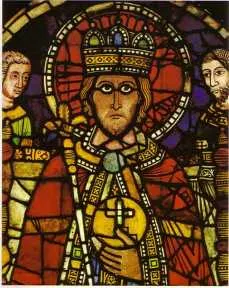
Conquest of Lombardy
The relationship between Desiderius, the king of the Lombards, and the young king of the Franks, was impairing very quickly. Charles repudiated Desideria who was very ugly. Pope Adrian I was looking forward to such an opportunity. As did his predecessor, he asked for help from the Franquish king. The Lombards was a constant threat for Charles, they wanted to rehabilitate the sons of Carloman, who were refugee at their court. Charles crossed over the Alps with his army, defeated the Lombards who took refuge in the city of Pavia, the capital of the kingdom. In 774, the city fell, and Charles took the title of « King of the Franks and the Lombards ». He came triumphant in the capital, crested with the famous iron crown, which according to the legend, included a clasp forged with a nail of the original Cross of Christ.
The Saxons, a hardliner opponent
Throughout his reign, the most substantial challenges that Charles faced concern the Saxons. A heaten people, as irreductible to the sword as the call of the gospel, who lived in the territories currently called Flanders and Lorraine, in addition to their homeland in Saxony (become Germany today). It took Charlemagne (from Latin « Carolus Magnus », Charles the Great) nearly a quarter century to subdue them completely. The Saxons, who had promised concessions, took advantage of the campaign of Lombardy to revolt again. But, they were again defeated and promised conversion to Christianity, Charlemagne came back with its share of hostages. Nevertheless, the revolts of the Saxons were running on…
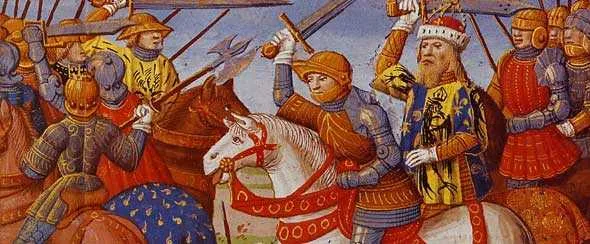
Against the Moors
For nearly a century, Christianity was threatened by the moors who were still in Spain. For the pope, like all Christians, Charlemagne had to defend them against this constant danger. Charlemagne never intended to conquer Spain, he was aware of the economic and cultural gap of both worlds. Moreover, he admired the Islamic civilization, very advanced in trade, craft industry, sciences and arts. Anyway, Charlemagne invaded Catalonia and took the city of Pamplona. Then, the bulk of the army had to withdraw back to Germania as the Saxons had rebelled again. The rear-guard, which protected the retreat, ensued in the Pyrenean valleys. It was leaded by Roland, Earl of Brittany, a valiant warrior beloved of Charlemagne. On August 15, 778, while it was crossing over the narrow gap of Roncesvalles, the Gascons (Basques) rushed down from the mountains and slaughtered the Franquish troops. « This bitter reversal, says a chronicler of the time, wiped out in the king’s heart the joy of success he had in Spain. » This event became the best known feat of the reign of Charlemagne, thanks to a poem writtent in the late 10th century, « the Song of Roland ». Charlemagne settled for keeping his possessions in Catalonia.
Ganelon, Roland’s stepfather, eager to take revenge on him and of the eleven peers who admire him, gets on to Marsile, a Saracen king, and gives all the information to destroy the rear-guard of Charlemagne. Roland is leading this rear-guard with his eleven peers, among them is Oliver, count of Geneva and Roland’s best friend. Therefore, Charlemagne was feeling a dark foreboding. Marsile gathered 400,000 men, who rushes on 20,000 Franks, landlocked in the pass of Roncesvalles. Pride, Roland refuse to sound the horn to recall Charlemagne. The first wave of Saracens (100,000 men) is blocked and exterminated. But after the fifth attack, the Franks are only more than 60. Roland decides to blow his horn, Charlemagne hears it but Ganelon dissuades him to move back. The battle still continues, Roland cuts Marsile’s hand who flees. Oliver, mortally wounded, finally dies in Roland’s arms. Roland is now alone with his friend Turpin. They are suddenly under attack of 400 Saracens, who riddled them with arrows before fleeing. Dying Roland tries in vain to break his sword « Durandal », that breaks a rock. Then, Roland set his face towards Spain and relies on God. Charlemagne, greatly affected, condemns Ganelon, the symbol of treachery. Roland’s fiancée Aude dies of grief. The poem is largely about Christianity and the wonderful love of knights for the « sweet France ».
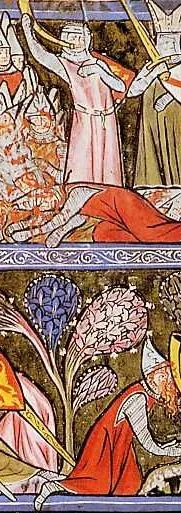
Difficulties in Germania
The intractable Saxons were again raised, they ravaged the French territory to the Moselle. Charlemagne organized so severe repression. Nevertheless, the revolts went on again. In 782, a Saxon chief called Widukind, Mais les révoltes n’en continuèrent pas moins. En 782, un chef saxon, Widukind, managed to decimate a Saxon army who had rallied the Franks. Then, he sought refuge in Danish territory. Charlemagne intended on annexing Saxony to his crown, but he had to make the Saxons give in. This became harder as the heathen applied military tactics from Christian. In retaliation, Charles decided to engage in a terrible slaughter. Near verdun, it was 4,500 Saxons who were executed, neither women nor children were spared.
The conquests in Central Europe
- In 779, the rise of the Saxons also emboldened the Duke of Bavaria, Tassilo III, who refused to recognize the sovereignty of the Franks and was about to cause trouble throughout the southern part of the Germania, occupied by the Franks. But foresaken by his subjects, Tassilo was finally defeated and imprisoned. Bavaria was well integrated into the kingdom in 788. Charlemagne impounded the huge property of Tassilo, who was considered “the richest man of the Empire”, more than Charlemagne himself who has never had a personal fortune. Indeed, he was one of the early kings in medieval times to distinguish the Royal Treasury and its property.
- Then, after Bavaria, Charles faced the Avars, a bellicose tribe from Mongolia, like the Huns, which was established in Pannonia (now Hungary). The war against the Avars was merciless. Charles replied to the ferocity of the enemy with the same ferocity. The confrontation ended with the capture of the Avar royal camp by Pepin, son of Charlemagne. Their lands were under the control of the Franks and converted to Christianity. Similar treatment was reserved for the Slavs from Bohemia. Following these achievements, the territories of Germania, Hungary, Bohemia and a part of Yugoslavia was released from the grip of the barbars.
Emperor
The coronation of Charlemagne
The relationship between Charlemagne and Pope Adrian I was not so perfect, Tuscany and South Italy was promised to the pope, but the Frankish king preferred to compel its own dominion over Italy. The independence of the Papal States was becoming more and more contestable. Still, Charles was concerned about its political construction, and he knew the power of the religious factor. So when the new Pope Leo III imprisoned in 799 and beaten by the nobles who accused him of immorality, Charlemagne intervened and ensured the return of the Pope in Rome under escort. In recognition of such a service, especially against the Lombards, Charlemagne took the new title of “Emperor of the Romans.” The ceremony took place at St. Peter’s Basilica in Rome on December 25 800. He was presented symbolically in a kind of successor of the Western Roman Empire. Thus, he took the monosepalous eagle as his emblem.
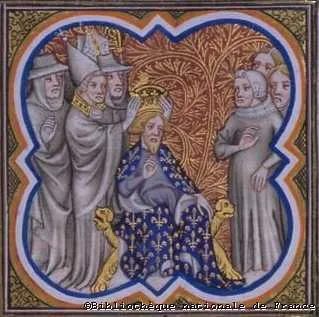
The conquest of Germania
The most difficult task for Charlemagne, was to submit definitely the Saxons in order to pacify and attach Germania to the new Franquish Empire. In 785, the barbarian chief, Widukind, fell ill, he was then forced to surrender his command. Therefore, Saxon campaigns were no longer laborious to the Franks who finnally won in 799. But guerrilla, repression and mass deportations resumed and was only completed in 804. That year, Charles had used great means, holding that “any unbaptized Saxon and who would refuse to, will be punished with the death penalty.” In addition, he deported the entire Saxon population residing between both rivers Elbe and Weser. As it was peaceful, Germania was divided into steps (area of defense) run by French leaders.
The organization of the Empire
The Carolingian Empire
In the early ninth century, the Frankish kingdom was already an immense empire and its frontiers were highly consolidated. After the coronation of Charlemagne, the midpoint of the empire moved eastwards, benefiting Germany instead of France. The capital city was established in Aachen, a german city as known as “Aix-la-Chapelle.” Charlemagne appreciated thermal waters from this area, to treat his gout and rheumatism. The announcement of the coronation did not please to Constantinople, where Charlemagne was like an usurper. However, in front of such power, the Byzantine Empire turned to transactions between the two empires. For a while, they thought married the Emperor of the West, to Irene, the Empress and Sovereign of the East, but the plan could not succeed. Actually, at that time, there are three rival empires: the Carolingian Empire, the Byzantine Empire and the Arab empire. This new world, because of religious antagonism hadn’t been able to take advantage of maritime trade, unlike the Roman world. This to explain the restructuring of the Frankish Empire that built an economic activity between the Rhine and the Meuse, promoting future Germany.

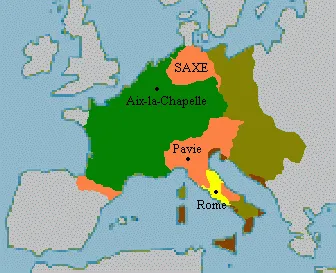
Man of war, man of peace
The portrait of Charlemagne is known to us by Einhard, a contemporary historian. Tall (he measured 1.92 m, 75 in), strong and vigorous, Charlemagne inspired the respect of his enemies on the battlefield, who were worried more by his physical strength than his tactical intelligence. He showed great kindness, he had used to give the poor alms, he could burst into tears after the death of a friend, and he revered his mother Bertrade who was a good advice-giver. Very attached to his family, he married four times but he never split up with his children. Charlemagne was an inquiring mind, he learned a lot of subjects in order to overcome his miss, and he gave a complete education to her children. But he was first and foremost a warrior, although his main aim was peace. Deeply religious, he was convinced that God had entrusted to the Franks to spread and defend the Christian faith, he spent his life fighting the barbarians from north to south Europe. By iron and blood, he managed to establish a Christian empire over much of Western Europe, to the point of attributing him the title “Pater europae”, father of the modern Europe.
The Missi Dominici
In this huge empire, the emperor could not always control if his orders were respected. Then, for important tasks, Charlemagne relied on people who were “the eyes, ears and tongue of the sovereign.” These were the missi Dominici (sent from the master). Real general inspectors of the kingdom, they had full authority to reprimand counts and marquis, to monitor justice and finance. The missi Dominici were usually composed of two persons: an ecclesiastic and a layman. Their aim was to investigate, supervise the administration of provinces and report to the Emperor the abuse they had witnessed.

Counts and marquis
Following the tradition of the Franks, Charlemagne divided the empire into counties (there were over 200 in the Empire); at the borders, he created marches, kind of buffer zones to defend against foreign invasions. Counties and marches, which were living in relative autonomy, were entrusted to the most faithful of his companions (counts and marquis). The emperor came periodically, in order to receive the representatives of the people and leaders of the clergy, control the accounts, decide to undertake some work. In each county were held regularly provincial assemblies or placiti (Latin placitum, convention), which served as courts. Judges or magistrates regulated the ordinary affairs. But the most important decisions were made by the count or the royal court.
Placitum Generalis and Marchfield
Counts and marquis were as kind of sovereigns in their territories. Actually, they were the vassals of the emperor, who was the real owner of the land. To centralize power, Charlemagne organized Placitum Generalis (“main placitum”, on average three times a year). All those who mattered in the Empire were invited: marquises, counts, bishops, abbots (upper Monastery)… In these meetings, they discussed all the problems of the Empire, and implemented laws. Then, officials of the Empire transcribed the text in an orderly manner into chapters. Marked with the signature and seal of Charlemagne, these chapters, or capitularies were widespread in the provinces to be applied. Charlemagne tried to replace the traditional oral decisions by writings. The Marchfield (which took place between March and May) was a Placitum Generalis which dealt with military issues.
By portraying the Emperor with a beard, when he was probably beardless, the representations of the sovereign tried to emphasize his virile authority. About the label of “flowing”, it is a wrong translation of “flori”, which means white in old French.
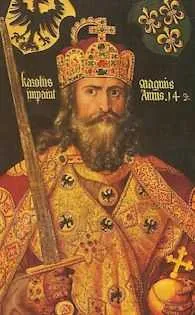
Carolingian society
A warmonger society
In the Carolingian Empire, the war was a vital parameter: it was considered as a normal activity, almost a necessity. During the reign of Charlemagne, the number of years without military campaign could be counted on one hand. The period of fighting was between May and October. The aims were different: put it back an obstinate count or traitor, raise booty by raids across borders, and of course, conquer territories and Christianize the infidels. From all parts of the empire came entire armies with bag and baggage, led by a count or a marquis. The emperor himself was reviewing the Frankish army. The Marchfield was not only an assembly of chiefs which decided the next military operations, but also an opportunity to reaffirm the unity of the Empire around the king and his army.
Carolingian society
- Serfdom, an economic motive: At the time of the Carolingians, economy was based on the work of the serfs. These were not exactly slaves, but of persons subject to a master, who would do the job they were ordered and remaining attached to a domain. The villae were especially important: agriculture living in autarky, that is to say producing all that is necessary for the life of its inhabitants, the villa was basic economic unit of the Empire.
- The clergy, the bond of the peoples: Throughout his reign, Charlemagne relied on the Church. Christianity formed the bond uniting the peoples of the Empire, who had shared neither the language nor the customs. Although he still closely watched over religious affairs, the Emperor gave a prominent place to the dignitaries of the Church.
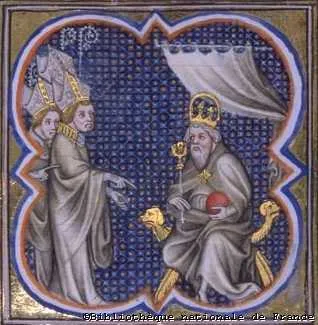
The Carolingian Renaissance
- Creation of Schools: To make competent administrators, Charlemagne encouraged a reformation of education; among other things he created the palace school, led by Alcuin. After many councils, Charlemagne succeeded in imposing religious reforms (reform of the liturgy, discipline in the monasteries, writing). Charlemagne was indignant about the rude style of some churchman, as the clergy should be educated; hence the establishment of schools close to churches and monasteries. The Church made an effort to educate the people. In monasteries, the copy of Scriptures is made with elegance (new writing rounder: caroline writing) and with a correct Latin.
- Charlemagne, the restorer of arts and letters: With the influence of Byzantine art, the churches were decorated with mosaics and frescoes. The bindings of Bibles were adorned with bas-reliefs; and also painted miniature or delicate illuminations. Relics and manuscripts were decorated by great goldsmiths. Arts and letters experienced a successful revival, the Latin language was restored, and brilliant people like Alcuin or Angilbert revived the taste of ancient culture. The architecture also undergoes a renaissance of art, inspired by Roman art. The religious buildings were booming, the palace of Aix also reflects the revival of civil architecture.
Einhard learned to Charlemagne this way for signing: a cross including letters of Karolus, the consonants are at the extremities, the vowels located in the central diamond.

The death of the sovereign
The death of the sovereign
After the subordination of the Saxons in 804, Charlemagne began his last military campaigns: against the Arabs of Spain, the Avars and the Britons, but also Slavs, Saracens, Greeks and Danes. In 812, the Eastern Roman Emperor Michael I recognized Charlemagne as Roman Emperor. Then, Charles thought about his succession:
- Among all his son, Pepin the Hunchback had tried to overthrow him, he was imprisoned in a monastery.
- Charles the Younger, who had received the anointing of the Pope at the coronation, was in the line of succession, but he died in 811.
- The second son of Charlemagne, Pepin, was king of Italy, he distinguished himself by capturing the treasure of the Avars, the “Ring”, he died in 810.
- Then Louis (the Pious and the Debonair) succeed to Charlemagne, he was consecrated in 813, during the lifetime of his father.
Charles was strong and robust, it was sick only during the last four years of his life, he began to limp and suffer fever. In 814, he died of pleurisy; he was buried in the basilica of Aix-la-Chapelle. The unity of the Empire which was already difficult to maintain because of the vast territory, stretching from the Baltic to the Adriatic, and because the system of counties and marches, the source of fragmentation, could be saved as long as Charlemagne was alive, but could hardly survive the disappearance of the “glue” that represented its authority and prestige.